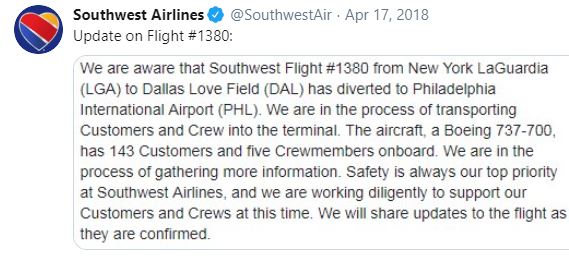Although it’s important to prepare for a crisis before it hits, sometimes the blow is much larger than your reputation can handle. And all that’s left for you to do is clean up the mess.
Your brand’s reputation
needs to be restored in order to avoid the crisis affecting how consumers perceive your brand — and the last thing you want is for people to stop buying your products or services.
You also don’t want the brand-consumer relationship to take a hit.
So, what do you do?
You bounce back!Here are three steps to making a comeback:
Step 1: Address the public
Your audience
wants to know what happened … so don’t skip out on any details! Issue out a public statement that addresses the crisis, explains
exactly what has occurred and lets people know how you plan on preventing the same thing from happening again.
Take, for example, Southwest Airlines. On 17 April 2018, fear-driven passengers from New York in the United States took footage of what was a dire situation on Flight 1380: the airplane’s engine exploded and had to make an emergency landing in Philadelphia. And with one casualty, people were, understandably, in a panic.
However, Southwest Airlines immediately took action. According to an article by Prezly, “
The Southwest staff had clear guidelines and checklists that allowed them to carry out the crisis response without anything slipping through the cracks.”
What PRs can learn: Although the details of the situation were awful, the airline took full responsibility and immediately took to Twitter to report on any updates about the state of the passengers, aircrew and the airplane.
 Image sourced from Twitter
Image sourced from Twitter
Additionally, they made a public statement,
pulled any advertising from their social media pages and made sure the passengers and were taken care of, both mentally and financially.
So, no matter how dire or gruesome the crisis situation, you need to be honest with people — so reveal as much detail as you can to avoid any further disaster!
Step 2: Own up to your mistakes
A brand that tries to defend its mistakes or justify its actions often ends up looking even worse to consumers, as it makes the brand seem even more guilty and, quite frankly, a bit dodgy. If the brand is not willing to admit to its faults, what else is it hiding?
One brand that admitted to its wrongs was Starbucks. Two black men in Philadelphia were arrested for merely waiting for a friend at the franchise on 12 April 2018, which immediately caused a backlash on social media and in traditional media, as the men were being racially discriminated against.
Starbucks was quick to respond and
issued a statement after the incident. The CEO also owned up to the brand’s mistakes in an interview with the
Inquirer and the
Daily News.
“Our concept has always been that Starbucks is in the community. "It's a gathering place … In this particular incident, we did not deliver on that warm, welcoming environment for those two gentlemen, and for that, I apologise to them."
What PRs can learn: It’s important for brands to acknowledge when they have made a mistake. You don’t want people to think that you’re just trying to justify what has happened, or that your brand isn’t aware of the severity of the situation. That’s why you need to own up to your mistakes and
rectify the situation as best you can.
Step 3: Turn the crisis into a marketing opportunity
One of the best ways to turn a crisis around is to turn it into a marketing opportunity. This will quickly turn your crisis into something positive, and will redirect the focus of consumers onto all the great things that your brand can do. It also shows that you’re a good sport and that your brand is just ‘human’ — mistakes
do happen.
Take KFC, for example. The food restaurant ran out of chicken in the United Kingdom and Ireland after some delivery delays. The restaurant’s PR and marketing teams immediately took action and issued an apology in the form of a campaign.
The campaign was placed adverts in newspapers and shows the rearrangement of the acronym ‘KFC’ to ‘FCK’ on its chicken bucket to own up to its mistake.
 Image sourced from 702
Image sourced from 702
The campaign gained a lot of positive feedback and even went on to win
Gold at the Cannes Lions Festival of Creativity.
What PRs can learn: KFC turning the situation into a hilarious campaign lightened the blow of the brand not having its products on offer to consumers, as everyone was able to laugh it off. Sometimes, being able to laugh at your own mistakes as a brand is the best way to make a comeback — provided that your consumers laugh along with you.
Are there any more steps you can think of that will help brands bounce back? Let us know in the comments section below.
Well, you’ve made it this far. Why not sign up for our newsletter while you’re here?
Sometimes, prevention is better than cure. Don't wait for bad things to happen before you have a solid reputation management plan in place. Get back to basics with Reputation management 101.
*Image courtesy of Vecteezy